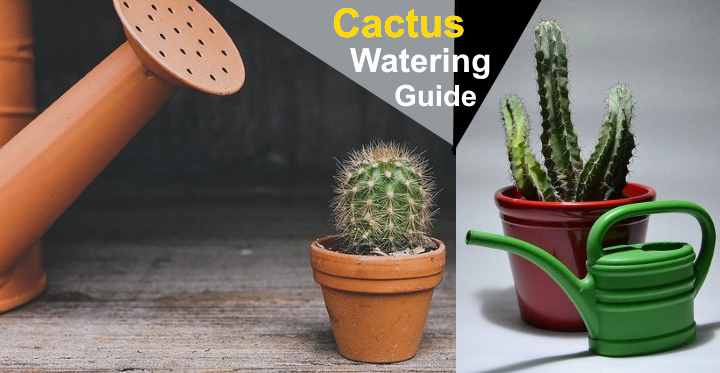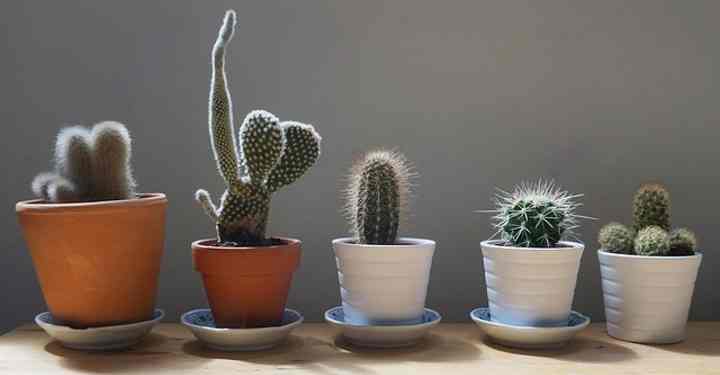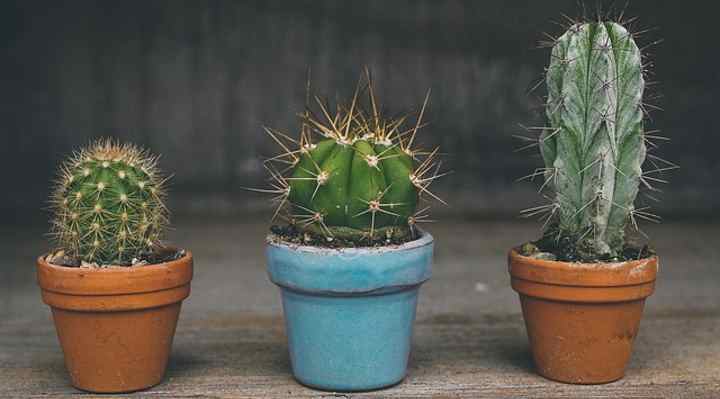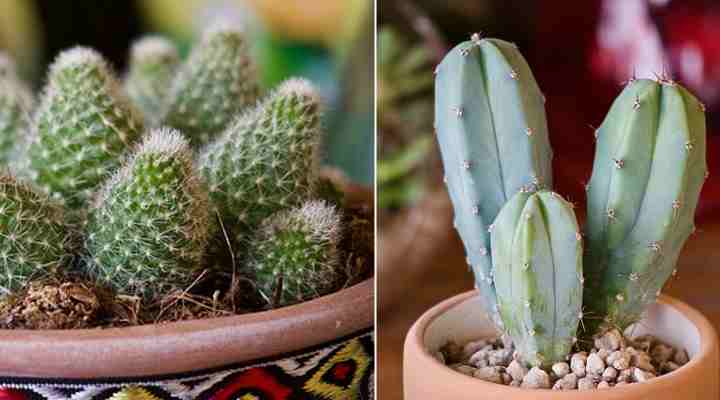How Often to Water Cactus Plants: The Ultimate Cactus Watering Guide

Cactus plants are easy houseplants to care for because they don’t need much watering. Of course, cacti, like any indoor plants, can’t survive without water. But after soaking the potting soil, cactus plants can live for weeks without water. You only have to water a cactus when the soil dries out.
Cactus is a type of succulent in the plant family Cactaceae. Cacti have thick fleshy stems that store moisture. Their ability to store water is a reason why they can survive periods of no watering or even drought. Their shallow root system quickly absorbs any moisture when they get watered.
Read on if you want to know how often you need to water a cactus. Also, you will find some tips and tricks to care for a cactus indoors.
How Often to Water Cactus

There’s no set schedule for watering a cactus plant, as you should only water it when the potting soil has dried out completely. The watering frequency of cactus plants depends on factors such as the size of the succulent plant, the type of pot, season, humidity, and how much sunlight it gets.
Don’t water your cactus plant on a set schedule, or you risk watering the plant too often. In summer, water more frequently than in winter.
Determining when to water a cactus depends on several variables such as the size of the succulent plant, the type of pot, and how much sunlight it gets. Also, some species of cacti are thirstier than others and require frequent watering. As a general rule, wait until the soil is dry before thorough watering of your cactus plants.
Let’s look in more detail at what factors determine when you should water your desert plant and how often you should do it.
Size of cactus
Typically, small cactus plants require more frequent watering than larger ones. Small cacti have a faster growth rate and therefore need more watering as their roots quickly absorb moisture. However, large cacti generally need more water when you drench the soil. In any case, always water cactus plants as often as the soil dries out.
The challenge with growing small types of cactus plants is not to overwater them. Because you need to water small cacti more frequently, they can succumb to root rot. So, don’t give them too much water so that you avoid any disease or pest issues.
Type of pot

Terracotta pots are the best type for growing cactus or succulents. These pots are made from a porous material that allows moisture to escape. Faster evaporation means that soil dries out quickly, and this benefits cacti. Planting cacti in terracotta pots enables you to water at regular intervals as the soil dries more evenly.
Your cactus terracotta pot should have at least one drainage hole. Holes in the bottom of the pot allow excess water to flow out when you soak the potting mix. To prevent the soil becoming too soggy, make sure that after watering your plant, excess water doesn’t gather in the drip tray.
Plastic or ceramic pots are not ideal for succulents or house cacti. These types of pots tend to hold in too much moisture, which can affect cactus growth. It also makes watering a cactus more problematic.
Size of pot
The size of the cactus pot can also affects the watering frequency. Large pots hold more moisture than smaller ones, so a large cactus in a big pot may need watering every four to six weeks. A cactus plant in a small container may need watering every one to two weeks.
Pick the appropriate pot size to the size of the cactus. If the pot is too large for the cactus, you will seldom have to water the plant. However, because soil stays damp for longer, your cactus may get soil mold or diseased roots. Try to pick the smallest pot for your cactus that gives support and enough room for the roots to grow healthily.
Getting the right soil for indoor cactus houseplants

Indoor cactus plants must grow in a potting mix with adequate drainage. Water should drain quickly through the soil so that it dries quickly, and so you can water your cactus properly. You can buy cactus potting mix. Or, you can combine potting soil, perlite, and coarse sand to make suitable cactus soil.
Fast draining soil for your cactus pot means that you need to water your cactus more often. However, house cacti growing in well-draining soil that gets watered appropriately will live for many years.
Temperature, humidity, and airflow for indoor cacti
Warm temperatures and good ventilation mean you have to water cacti more often. Heat causes soil to dry out quicker and causes plants such as cacti to transpire more. But that’s good because it means your cacti are healthy and thriving. Check the soil every few days to see if you should water the plant.
Of course, in cooler temperatures—during fall and winter—your cactus needs much less water. House cactus growth slows down in the winter months and so they don’t need frequent watering. In fact, you might only have to water a cactus in winter every one or two months.
One of the great things about these drought-tolerant plants is that they love low humidity. Dry indoor air is just right for growing cactus. What are the ideal humidity levels for growing indoor cacti? Aim for 20 to 30 percent humidity. You never have to mist cacti stems. The only care they need is plenty of sunlight and watering occasionally.
Season

As a general rule, water house cactus more often in summer than you do in winter. Apart from heat causing the soil to dry out, healthy cactus plants grow vigorously in spring and summer. During these months, the succulent plants may need watering once a week. In the fall and winter, growth goes dormant—so, only rarely water them and never feed them.
Of course, always check that soil is completely dry before thoroughly watering the house cacti.
Light requirements to grow cactus plants
The amount of sunlight cacti get also affects how often you have to water them. Cactus plants need about 12 hours of sunlight daily to thrive. Of course, bright sunlight dries out cactus soil rapidly. Check the soil every two or three days to see if it needs water.
The best location for growing cacti is in a south-facing window. Here it will grow well in direct sunlight and regular watering. Cactus can also grow in lower light conditions—for example, a north-facing room. However, you will need to adjust the watering schedule and water the plants less frequently.
How to Water a Cactus

When you water a cactus, thoroughly soak the soil with plenty of water until it drips out the bottom. You might think that this is too much water. However, saturating the soil ensures the roots get plenty of moisture. Although cacti can survive drought, they thrive when the dry potting soil gets an occasional drenching.
Remember, the next time to water your cactus is when the potting soil has become dry. So, pouring plenty of water through dry soil is the best way to water the plant. The cactus roots then absorb the moisture, and the succulent keeps its vibrant, healthy appearance.
How Do You Know When a Cactus Needs Water?
If you under-water your cactus, you’ll notice that it starts to wilt and become limp. When the plant-soil has been arid for too long, the cactus loses its vibrant color and will begin to fade. Noticing signs of an under-watered cactus means it’s time to soak the soil thoroughly to revive a wilting cactus.
It’s a mistake to think that indoor cacti can survive for many months without water. Some succulents and cacti are desert plants and can live a long time without rainfall. However, outdoor cacti are usually able to store more moisture and absorb more water from the ground.
The classic signs of under-watering a cactus
- Green stems or leaves that appear limp and withered
- The plant may start leaning to one side
- Under-watered cacti become paler
- Fleshy cactus or succulent leaves appear dimpled
- The cactus is soft to touch
Don’t panic if you’ve forgotten to water your cactus for many weeks. These hardy houseplants are quite forgiving and usually just need deep watering to bring them back to life. After the cactus starts growing healthily, check the soil for dryness every few days in spring and summer and every few weeks in winter.
How to Tell If You Overwatered a Cactus

Overwatering your cactus too much will cause the fleshy stems to appear bloated and full. The damp, soggy, or waterlogged soil can also severely affect the roots. The visible signs of root rot are leaves that turn black or yellow or drop off the plant. The emerald green leaves can also become translucent and mushy.
Being overly enthusiastic when watering cactus plants is more serious than underwatering. If the root damage is severe, it might not be possible to save an overwatered cactus. Apart from mushy roots not being able to absorb moisture, the plant can develop various fungal or bacterial problems.
The reason why you should never water a cactus too much is due to its delicate root system. Succulents have sensitive, shallow roots that are easily damaged. It is also difficult to recognize the first signs of overwatering. The cactus can appear plump and healthy, but the roots could be rotting away in wet soil. Then, when you realize there are watering issues, it can be too late to save the succulent cactus.
How to Spot Signs of Root Rot Due to Overwatering a Cactus
- The fleshy leaves or stems appear plump and swollen
- Leaves start turning brown or black
- Leaves can become mushy and translucent
- Leaf drop
- The cactus stem starts leaking
- The roots are black and mushy
How to Save a Dying Cactus Plant
If you notice signs of overwatering, it’s essential to stop watering it immediately. You should remove the cactus from the pot and examine the roots. Healthy cactus roots are white and sturdy and won’t break easily. Any mushy brown or black roots need cutting off if you hope to save the cactus.
With sterile shears, cut off all decaying plant matter. Repot in dry, fresh potting mix and leave it for one week before watering. In the future, only water the cactus when it needs it—i.e., the soil is bone dry.
How to Fertilize a Cactus Plant Indoors

Cacti don’t have a lot of feeding requirements; however, the succulent plants benefit from occasional feeding. You can fertilize a cactus two to three times a year—once in spring, summer, and then the fall. Regular, low-nitrogen houseplant fertilizer is fine if you dilute it by half.
Most people assume that cacti only survive in hot arid climates and get a deluge of water once in a while. While some outdoor cacti grow well in desert environments, indoor cacti need a bit more care. When feeding cactus plants, remember that it’s the same principle as watering—overfeeding is just as bad as too much water.
Other Cactus Growing Tips
Knowing when to water a cactus is the most important factor when caring for house cacti. What else should you know about growing indoor cacti plants? Here are a few tips on growing these hardy houseplants:
Type of cacti—Some kinds of cacti are desert plants, whereas others grow in forests. Types of cacti that are native to the desert require direct sunlight. Forest cacti prefer bright, but indirect light. Some cactus plants, such as the moon cactus, are some of the most unique houseplants you can grow.
Temperature—Desert cacti prefer hot, dry temperatures between 70°F and 80°F (21°C – 27°C). Forest cacti thrive indoors in temperatures ranging from 55°F to 70°F (12°C – 21°C). During winter, succulents prefer temperatures around 50°F to 55°F (10°C – 12°C). If you look after your cacti properly, they may even bloom indoors.
Soil—The right type of potting medium for cacti should be well-draining, sandy soil. Keep pH levels between 5.5 – 7.
Pests—Cacti, just like any houseplants, can be prone to pests. Some common pests to infest cactus plants are scale, mealybugs, fungus gnats, and spider mites. Find out here how to get rid of indoor plant bugs.
Related articles:
